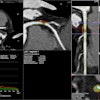
The combination of radiomics and a machine-learning algorithm can differentiate benign from malignant renal masses, potentially helping to avoid unnecessary surgeries, according to research published online September 17 in European Urology Focus.
A team of researchers from the University of Southern California (USC) in Los Angeles trained a machine-learning algorithm that utilizes radiomics analysis of preoperative CT scans to distinguish between benign masses and renal cell carcinoma. In testing, the model yielded an area under the curve (AUC) of 0.84 and also increased the accuracy of negative and nondiagnostic biopsies.
"In this cohort, had surgical intervention been based on the combination of clinical and radiomic predictors of malignant disease, the number of unnecessary surgeries could have dropped to 3.5%, resulting in a fourfold reduction in unnecessary surgical intervention rate," wrote the authors led by Dr. Nima Nassiri.
Approximately 25% of patients with kidney tumors receive surgery but are ultimately found to have benign pathology, according to the researchers.
"A substantial proportion of patients undergo treatment for renal masses where active surveillance or observation may be more appropriate," the authors wrote.
As a result, the group sought to determine if machine-learning algorithms based on radiomics analysis could be utilized to distinguish benign from malignant masses prior to surgery. Radiomics analysis was performed on multiphase CT scans of the abdomen and pelvis in 684 patients who had a clinically localized renal mass.
Of these patients from their institution's renal mass registry, 521 (76.2%) had renal cell carcinoma while the remaining 163 (23.8%) had benign oncocytomas or angiomyolipomas. In addition, 57% of the patients had small renal masses, of which 73% were malignant.
Important clinical and radiomics variables were identified and incorporated into random-forest and Real Adaboost machine-learning predictive models. Next, the researchers employed 10-fold cross-validation to assess the performance of the algorithms. They then compared the results from the clinical and radiomics analysis model's with a clinical nomogram, as well as models that analyzed only clinical factors or radiomics.
| Performance for differentiating benign renal masses and renal cell carcinoma | ||||
| Clinical nomogram | AI with clinical factors alone | AI with radiomics analysis alone | AI with both clinical factors and radiomics | |
| AUC | 0.50 | 0.62 | 0.83 | 0.84 |
Interestingly, radiomics analysis alone produced the highest diagnostic performance -- AUC of 0.77 -- for differentiating benign and malignant small renal masses (tumors < 4 cm in size). Adding clinical factors to the radiomics analysis did not significantly improve the algorithm's predictive capacity for these masses, according to the study authors.
The researchers also evaluated the concordance of the radiomics analysis and percutaneous biopsy with the final pathological results. Adding radiomics analysis to cases with negative or nondiagnostic biopsies increased sensitivity from 81% to 92.5% and accuracy from 83.3% to 93.4%.
"A machine learning predictive model that incorporates radiomic analysis may distinguish benign pathology from [renal cell carcinoma], without the need for adjunctive imaging or procedures and within the context of guideline-recommended workup," the authors wrote. "The model may be particularly helpful in patients with [small renal masses] and those with equivocal biopsy results."




















